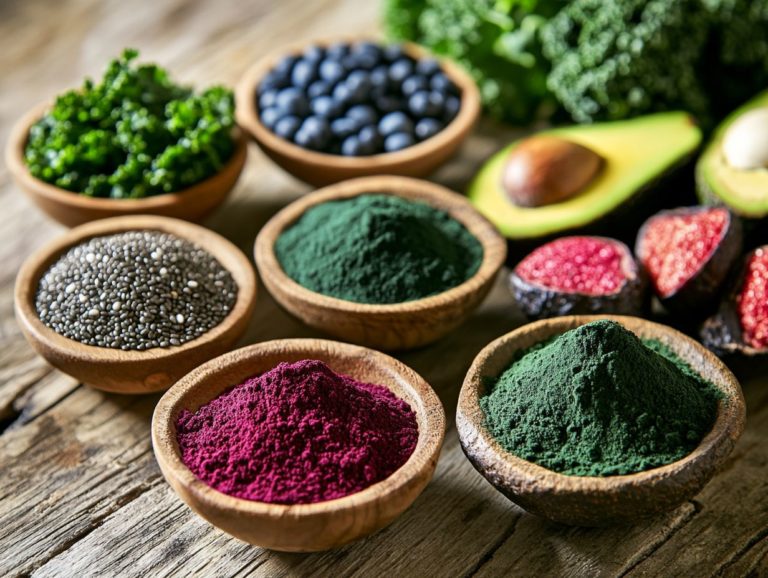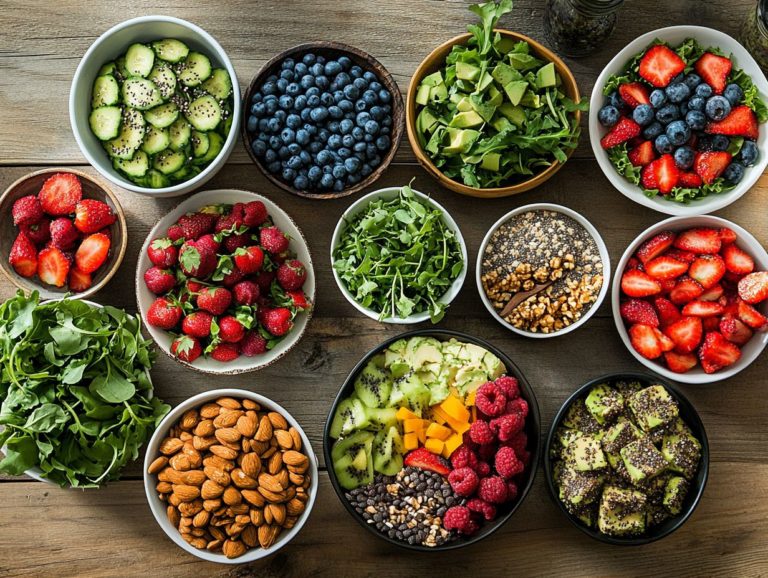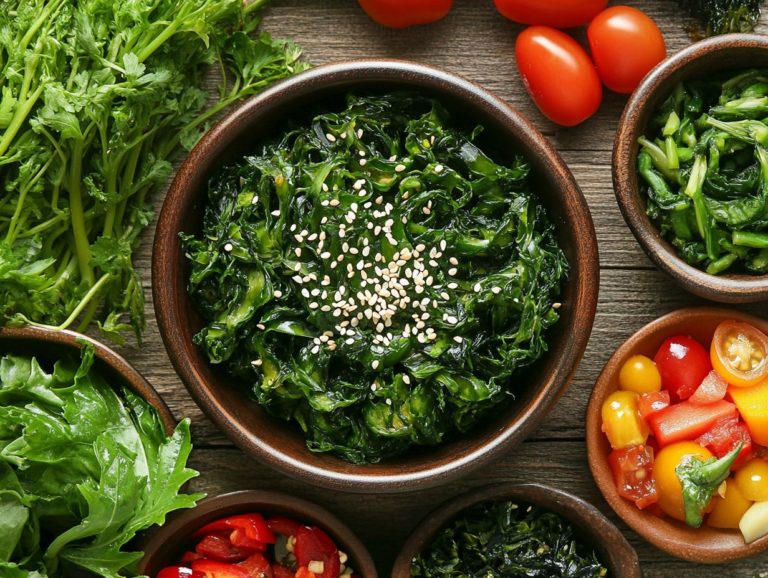Superfoods Around the World: A Global Perspective
In a world that increasingly prioritizes health and nutrition, superfoods have risen to prominence as the shining stars of the dietary landscape.
These nutrient-packed foods promise a plethora of health benefits and carry rich histories and cultural significance from every corner of the globe.
From the traditional staples of Asia to the vibrant indigenous ingredients of Africa, Europe, and the Americas, each region provides its unique perspective on what elevates a superfood to greatness.
Dive into the diverse world of superfoods that nourish both bodies and cultures, uncovering their benefits, nutritional value, and the fascinating stories that bring them to life.
Contents
Key Takeaways:
- Superfoods are nutrient-packed foods that offer numerous health benefits, and their popularity is on the rise globally.
- Asia, Europe, Africa, and the Americas each have unique superfoods that have been used for their traditional, nutritional, and cultural value for centuries.
- From matcha in Japan to quinoa in Peru, incorporating superfoods from around the world into your diet can add a variety of nutrients and flavors to your meals.
Defining Superfoods and Their Popularity
Superfoods have surged in popularity recently. It s easy to see why they offer a wealth of health benefits think enhanced gut health and powerful antioxidant properties.
Foods like goji berries, quinoa, and chia seeds have captivated health-conscious consumers around the world. This trend is driving significant market growth and reshaping how we view health food.
These superfoods also support sustainable practices and Fair Trade initiatives, spotlighting indigenous knowledge and historical diets. This rising trend reflects a broader shift where you, the discerning consumer, are increasingly seeking products that are not only nutritious but also ethically sourced.
Take goji berries, for example; they re celebrated for their immune-supporting abilities and their knack for tackling oxidative stress. And quinoa? Its complete protein profile makes it a go-to for both vegetarians and athletes alike.
But the impact of this superfood movement goes beyond personal health it s reshaping economic landscapes in developing countries. The growing demand for these products can create new income opportunities for local farmers. This intricate interplay of health benefits, market trends, and socio-economic factors underscores a heightened awareness of your food choices and their potential global impact.
Superfoods in Asia
In Asia, the notion of superfoods is deeply woven into the fabric of traditional diets. Here, native plants such as goji berries, turmeric, and moringa are not merely culinary delights; they are revered for their remarkable health benefits, including powerful anti-inflammatory and antioxidant properties.
You ll often find these superfoods seamlessly incorporated into herbal teas and diverse dishes, showcasing the region s unwavering dedication to personal wellness through time-honored food staples that have stood the test of time.
Traditional Superfoods and Their Benefits
Experience the incredible benefits of traditional superfoods like turmeric and various omega-3-rich options! They are celebrated for their remarkable health benefits, ranging from enhanced gut health to high fiber content that supports healthy cholesterol levels.
These vibrant superfoods have been cherished in diets for centuries, each with unique flavors and benefits. Take turmeric, for instance. Revered in Ayurvedic medicine, it contains curcumin, a powerful compound in turmeric known for its potent anti-inflammatory and antioxidant effects, potentially reducing the risk of chronic diseases.
On the other hand, omega-3-rich foods such as flaxseeds and fatty fish have graced diets across cultures from Mediterranean to Asian cuisines praised for promoting heart health and cognitive function.
Incorporating these superfoods into your diet leads to a balanced intake. They offer not just essential nutrients but also longevity benefits that contribute to your overall well-being. The historical significance of these foods underscores their lasting popularity and relevance in today s nutrition conversations.
Explore the world of superfoods and transform your diet for a healthier lifestyle!
Superfoods in Europe
In Europe, people are increasingly interested in superfoods as staples for health-conscious consumers. There’s a burgeoning interest in organic superfoods like quinoa. Quinoa is celebrated for its diverse recipes and cooking flexibility.
This trend impacts the economy significantly, fueling demand for Fair Trade methods that ensure farmers get fair pay for their products and fostering sustainable production methods across the region.
Popular Superfoods and Their Nutritional Value
Popular superfoods like cacao, chia seeds, and sacha inchi are gaining well-deserved praise! They offer high levels of protein, fiber, and essential vitamins and minerals.
The extensive health benefits tied to these superfoods have become essential in health foods and supplements. These nutrient-dense foods are especially renowned for their antioxidant properties, which play a crucial role in combating oxidative stress and inflammation within the body.
Incorporating them into your daily meals is simpler than ever! For instance, chia seeds can add a delightful texture to smoothies and oatmeal, while cacao elevates the flavor of health-conscious desserts.
Sacha inchi, available in both nut and oil forms, introduces a unique flavor to salads and snacks. This makes it a versatile option for contemporary diets. As people increasingly prioritize holistic wellness, the rising popularity of these superfoods is inspiring a shift toward cleaner and more generous eating habits.
Superfoods in Africa
Africa boasts an impressive array of superfoods, each steeped in rich indigenous knowledge and traditions. Ingredients like baobab fruit and fonio shine with their exceptional nutritional benefits.
These superfoods are not merely important for your personal health; they also play a pivotal role in enhancing food security and promoting sustainable practices. Ultimately, they support the economic vitality of local communities.
Indigenous Superfoods and Their Uses
Indigenous superfoods like moringa and saskatoon berries have always been valued for their medicinal properties and cooking flexibility. This reflects the rich cultural heritage of their regions.
Their traditional uses underscore the importance of indigenous knowledge in promoting wellness and nourishing diets. This highlights the vital role these superfoods play in contemporary health food trends.
Take moringa, often called the “miracle tree.” Its nutrient-dense leaves are a treasure trove of vitamins and minerals, serving as a cornerstone of nutrition in many local communities.
Then there are saskatoon berries, bursting with antioxidants. They are not only known for their delightful flavor but also for their traditional role in boosting immune health.
These extraordinary foods exemplify the profound connection between people and their environment. Millennia of wisdom shape practices that are increasingly relevant in today s health-conscious society.
By reviving and appreciating these superfoods, you contribute to the preservation of indigenous cultures and the promotion of sustainable farming practices.
Superfoods in the Americas
In the Americas, native superfoods like quinoa and acai are not only trending but are also essential components of the health food market. These ingredients are celebrated for their impressive nutritional benefits, but their cultural significance within indigenous communities is equally noteworthy.
This newfound recognition is driving market growth and enhancing awareness of their economic impact. Ultimately, this fosters a deeper appreciation for traditional diets and sustainable practices.
Native Superfoods and Their Cultural Significance
Native superfoods, like quinoa and sacha inchi, carry deep cultural significance, representing the historical diets of indigenous communities and their profound connection to the land. These superfoods are not just foods packed with nutrients; they act as a bridge linking contemporary health practices with traditional ways of life.
The cultivation of these nutrient-dense foods reflects centuries of agricultural wisdom passed down through generations. This showcases how communities have adeptly adapted to their environments. Quinoa, often dubbed the “mother of all grains” by the Andean peoples, underscores its invaluable role in their sustenance and cultural identity.
Meanwhile, sacha inchi, renowned for its omega-3 fatty acids healthy fats beneficial for heart health embodies the holistic nutritional approach embraced by indigenous societies. By adding these superfoods into your modern diet, you tap into a growing recognition of their potential to enhance health while honoring ancient traditions. This helps you create a diet that nourishes not only your body but also respects the earth and its rich cultural heritage.
Frequently Asked Questions
What are superfoods?
Superfoods are highly nutritious foods that are rich in vitamins, minerals, and antioxidants. They are considered to be beneficial for overall health and well-being.
What makes a food a superfood?
A food is considered a superfood if it is densely packed with nutrients and provides significant health benefits. Superfoods are usually plant-based and contain a high concentration of antioxidants, healthy fats, and other beneficial compounds.
What are some popular superfoods from around the world?
- Acai berries from Brazil
- Quinoa from Peru
- Matcha from Japan
- Turmeric from India
- Chia seeds
- Goji berries
- Spirulina
Are superfoods only found in exotic locations?
No, superfoods can be found all over the world. While some may be more commonly associated with certain regions, many superfoods can be grown and found in various countries. For example, blueberries are considered a superfood and are grown in many different countries, including the United States, Canada, and Chile.
Can anyone incorporate superfoods into their diet?
Yes, superfoods can be incorporated into anyone’s diet. Whether you are a vegetarian, vegan, or have dietary restrictions, there are many different types of superfoods that can be enjoyed. It’s important to consult with a healthcare professional before making significant changes to your diet.
Are superfoods a replacement for a balanced diet?
No, superfoods should not be considered a replacement for a balanced diet. While they provide many health benefits, they should be consumed as part of a well-rounded and nutritious diet. It’s important to eat a variety of foods to ensure you are getting all the necessary nutrients for optimal health.
Discover how to include these superfoods in your meals today!




